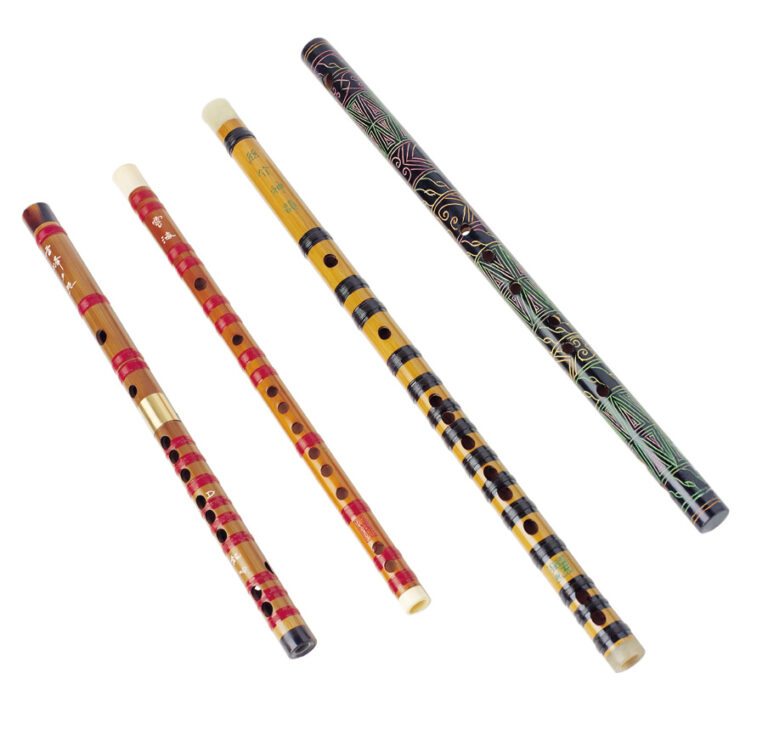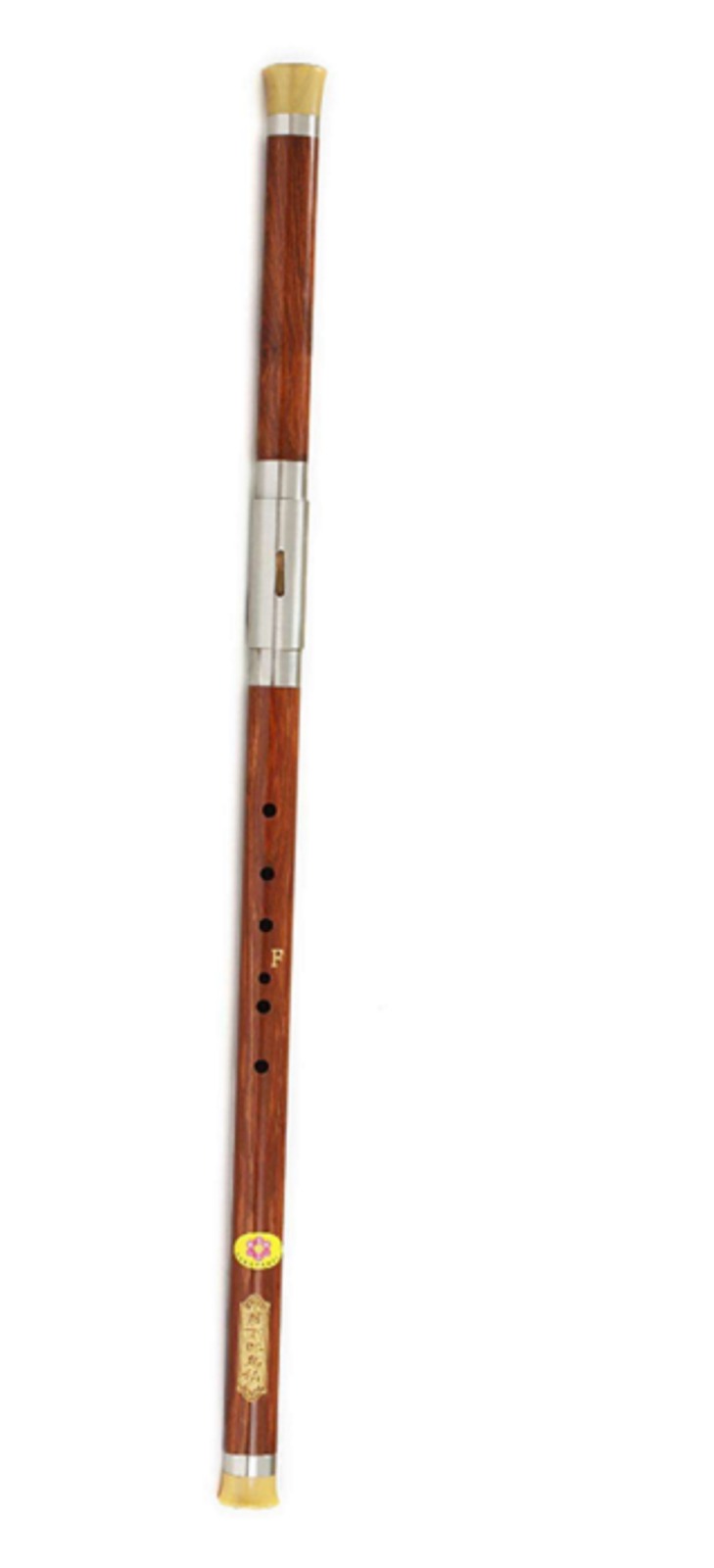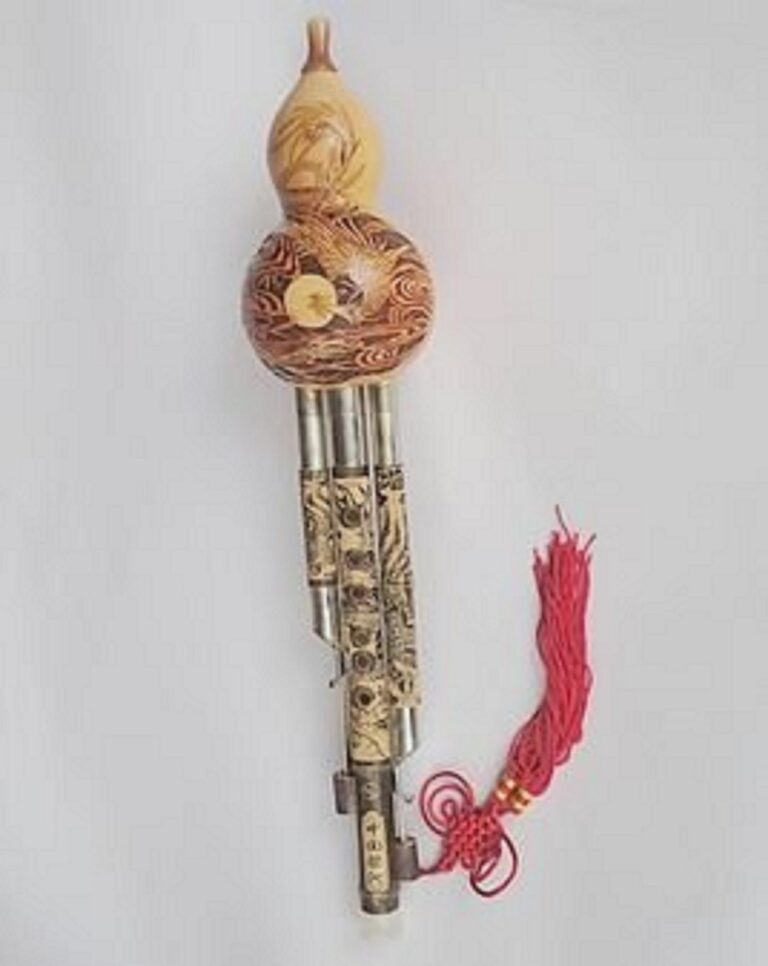中國民族音樂資料館 Chinese Music Archive
吹管类 Other Wind Instruments
笛子 - Dizi
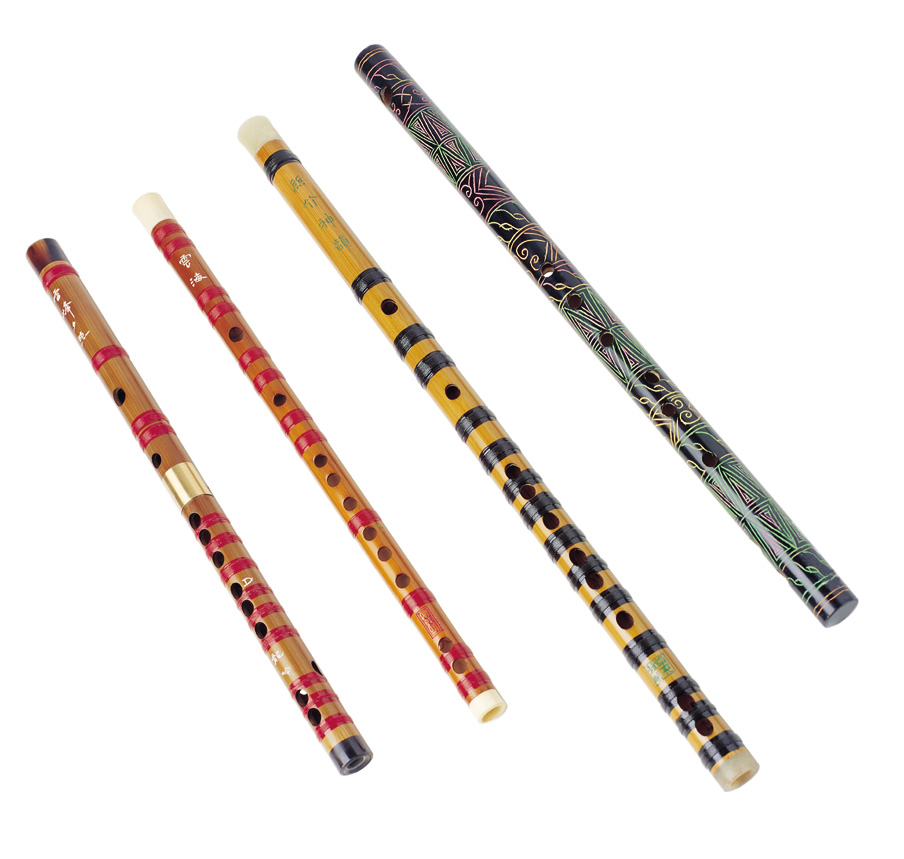
笛子,古代称为“横吹”,后来又称“横笛”。相传汉武帝时(公元前一四○至八七年),张骞到了西域(即现在的中亚细亚一带)以后,才开始将吹笛的方法,传到当时的首都长安(即现在的西安)。从汉墓的拓片和敦煌的壁画中都有笛子这一点来看,可以相信,我国至少在二千多年以前就已经有了这样的乐器。笛子传入后,人民在长期演奏的实践过程中,结合了本民族的特点和喜爱,创造性的发展了笛子的演奏技术。如在宋、明之间,民间流行了半孔按法。这种情况,在宋代陈暘《乐书》、明代朱载堉《律吕精义》与朝鲜的《乐学轨范》中,都有详细的记载。
目前民间各地流行的笛子,种类很多。有伴奏南方昆曲或其他地方戏曲的曲笛;有伴奏北方梆子戏的梆笛;还有民间各地局部流行的笛子。除此以外,在新中国成立后,各文艺工作团体还开始应用了他们试制的各种改良新笛。虽然笛子的种类很多,但在民间较普遍应用的,是曲笛和梆笛两种。
笛子是一种竹制的乐器,上开有吹孔和膜孔各一,按指孔六个,音色清脆,音域较宽,能吹两组多一点的音;梆笛比曲笛短小,在音高上,比曲笛高一个纯四度。曲笛的音色柔美而清脆,梆笛则高亢而明朗。这二种笛子除伴奏戏曲外,也普遍地应用于独奏、合奏和民歌、舞蹈的伴奏;伴奏时,它往往以主要乐器的地位出现。
新中国成立后,对笛进行了多次改革,先后制出了成套的十二调的笛,并在曲笛的基础上改制了加键笛,保留原有的六个音孔,用键子控制新增的半音,便于临时升降半音及转调。
Dizi was called the Horizontal Winds in ancient times. Later on, it was also called the Horizontal Flute. It was told that ZHANG Qian of the Han Emperor Wu (140 to 87 B.C.) firstly brought back the method of performing the dizi from the Western Regions out of China to the capital Chang’an. It was clearly showed that from the rubbings of the ancient tombs and murals of Dunhuang of Han dynasty, dizi was used as musical instrument at least 2,000 years in China. Since that on, Chinese people had made long-term practices on performing which developed most of the performing techniques of dizi. These were reflected in full details on the Book of Music by CHEN Yang of the Song dynasty, the Meaning of Lulu (pitch) by ZHU Zai-yu of the Ming dynasty and the book Trend of Music of the North Korea.
At present, there are different kinds of dizi be used in the Chinese music. The most popular ones are the qudi used in the operatic music of the southern areas, such as Kunqu and the bangdi used in the operatic music of the northern areas, such as Bangzi. There are still other kinds of dizi be used in local music. After the establishment of New China, musicians have made improvements on the traditional dizi and invent some kinds of new ones. Although there are many types, the most popular ones are the qudi and bangdi.
Dizi is made with bamboo and has a range of more than two octaves. Along the bamboo, there are one hole for blowing, one hole for the membrane and six holes for the scale. Bangdi is much smaller and the pitch is higher than that of the qudi. These two kinds of dizi are the main instruments of the ensemble. Besides of opera accompaniment, they are also used as solo instruments and accompaniment for folk songs and dances.
Nowadays, there are new reformations on dizi. In preservation of the traditional six scale holes, there is a mechanic-operated system to be applied for the newly added semitone holes. A complete set of twelve different pitch dizi is manufactured for the use in modern compositions, etc.
笙 - Sheng
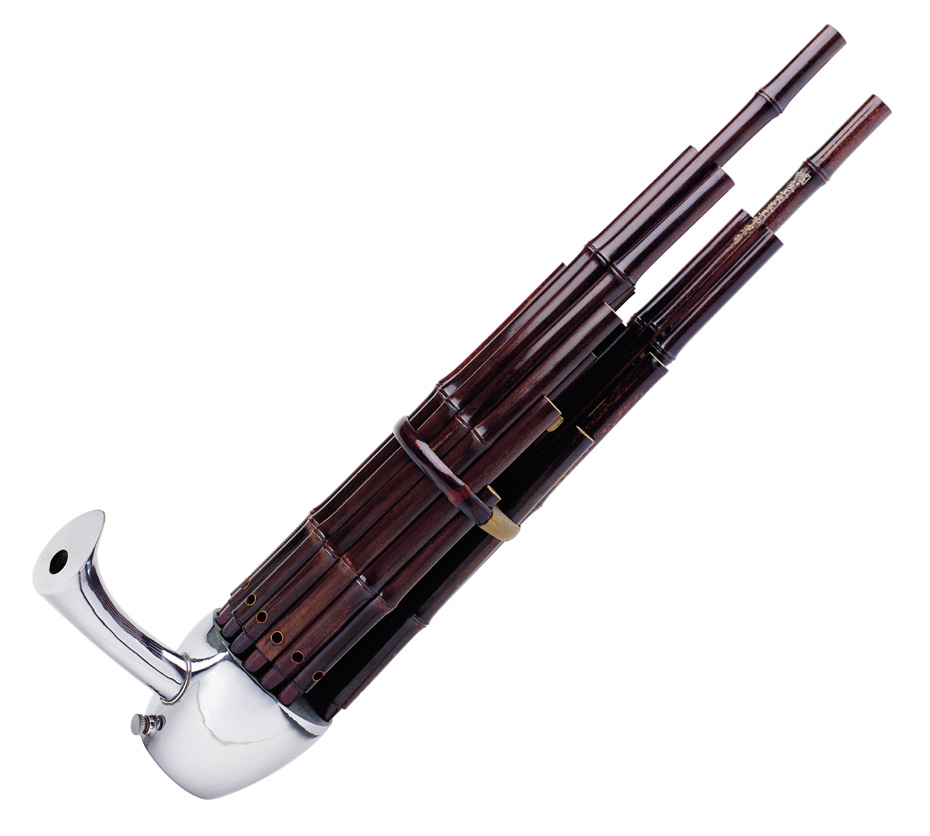
笙,是我国古老的簧管乐器。殷代(公元前一四○一至前一一二二年)的甲骨文中已有“和”(小笙)的名称。在春秋末期的《诗经》中,也经常提到它。春秋战国时期,笙是最主要的一种乐器,大的名竽,有三十六簧,早期的簧为竹制,后来改为铜制。长沙马王堆三号汉墓出土的汉初的竽,有二十六管,簧为竹制。
南北朝到隋唐时期,主要有十九簧、十七簧、十三簧的笙,唐代又有十七簧的义管笙,在十七簧之外,另备两根义管,需要时,才将它临时装上去。北宋景德三年(公元一○○六年),宫廷乐工单仲辛把义管笙恢复为十九簧笙,当时曾普遍应用。
北宋初年(约在公元九六○至九六五年间),四川地区曾出现一种装有三十六簧的凤笙,但未流传开来。
明清时期,民间流行的笙有方、圆、大、小各种不同的类型。有一种能转四个调的十七簧笙,在个别乐队中使用,但普遍流行的是十三簧和十四簧笙。
笙的构造是,将铜制的簧片装在若干竹管下端,这些竹管插在一个匏制、木制或铜制的带有吹口的斗子上。吹时用指按著竹管下端所开的孔,即能使簧片与管中气柱发生共鸣而发出乐音。演奏时,除偶然使用单音外,大都用二音、三音或四音配合成和音。
新中国成立后,对笙进行了不断地改革,已有二十一、二十四、二十五、二十六簧及加键笙、带共鸣筒笙等多种类型的笙出现。近年还试制了一种三十二簧笙。这种笙音域较宽,音量较大,具备十二个半音,转调方便。
笙的吹奏技术也有较大的发展,除了用于伴奏、合奏以外,已发展为独奏乐器。
Sheng was China’s oldest wind reed instrument. The small sheng was called he (1401 to 1122 B.C.). Later on, it developed to be the main instrument. The big sheng was called yu and had thirty-six reeds. In the early times, the reeds were made of bamboo, and it was changed to brass in later time. The unearthed yu of Han dynasty had twenty-six bamboo reeds. In Tang dynasty, they were mainly nineteen, seventeen and thirteen reeds. In Sichuen, there appeared a thirty-six reeds sheng in early Song dynasty. It was the thirteen and fourteen ones popularly be used in Ming and Qing dynasty. But there were one which could modulate in four keys and it was used only in special ensemble. The sheng was constructed by installing a number of bamboo tubes with reeds on the end of each tube to the wood or brass container which had a blowing end. The bamboo tubes were tuned in different pitch with a sound hole. By closing of these sound holes through fingering, we can perform melody from it. Nowadays, the sheng has constantly reformed to have twenty-one, twenty-four, twenty-five and twenty-six reeds with key controls. Besides used in accompaniment and orchestral works, sheng has been developed into a solo instrument.
芦笙 - Lusheng
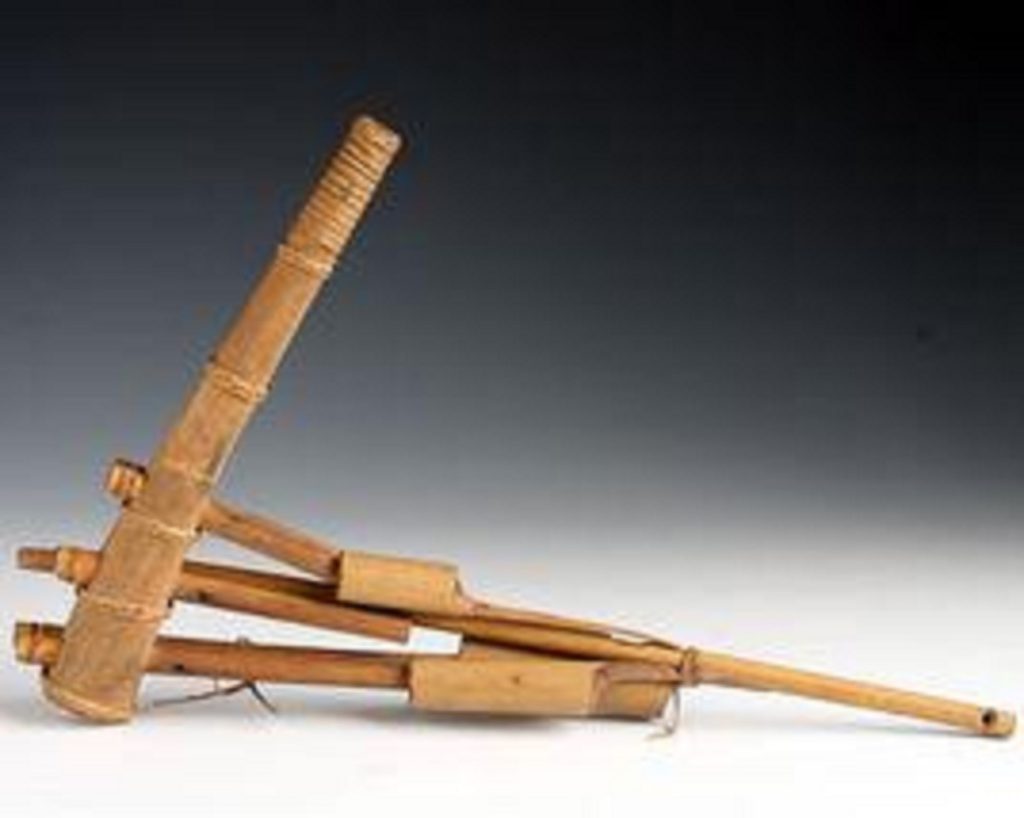
芦笙,为西南地区苗、瑶、侗等民族的簧管乐器。早在西汉初已出现。南宋范成大《桂海虞衡志》中,曾提到他当时在广西所见到的瑶族八管芦笙。
芦笙大小不一,管的数目也不尽相同,单管、双管以至五管、六管、八管、十管都有,但较常用的是六管芦笙。六管芦笙是用六根长短不一的竹管,分成两排插入木制的笙斗中;每管的根部各装一个铜质簧片;管的下端各开一个小孔,吹奏时手指按孔发音。有的芦笙,在竹管上端套上竹篾折成的三角形喇叭或套上稍大的竹筒,起共鸣作用。吹奏时,以单音奏旋律,同时发出两个以上的和音作伴奏。
芦笙多用于独奏、合奏和舞蹈伴奏。贵州苗族地区,有大小不同的四种芦笙组成的乐队,并且有一整套传统的芦笙曲。
新中国成立后,对芦笙进行了多次改革,先后有十五管、二十管、二十六管、三十六管的芦笙出现。有的将木制笙斗改为金属笙斗,有的加上音键,扩大了音域,能吹奏十二个半音,解决了转调的问题,能演奏较複杂的乐曲。
Lusheng was the wind reed instrument of Miao, Yao and Dong region of the south-west China. It was said to be appeared in Han dynasty. FAN Cheng-da of the Song dynasty mentioned in his book that he had seen an eight-tube lusheng of Yao tribe. The size and the number of tubes of lusheng are different. There are usually single, double, five, six, eight and ten tubes instruments and the most popular is the six-tube one. It is to use six tubes of different length inserted in two rows into a wooden container. The tubes are installed with brass reeds at the end tuning at different pitch with small holes. By pressing these holes to produce musical sounds. It can play single sound and also cords. It is used for the solo, ensemble and dance accompaniment. At the Miao region of Guizhou, there are ensembles of lushengs with four different sizes and they have their complete set of traditional music. Nowadays, lusheng has been steadily reformed for many times. It has modified to consist of fifteen, twenty, twenty-six and thirty-six tubes instruments. The wooden container has changed to metallic. The scale is upgraded to have twelve semitones and can play more complex music.
箫 - Xiao
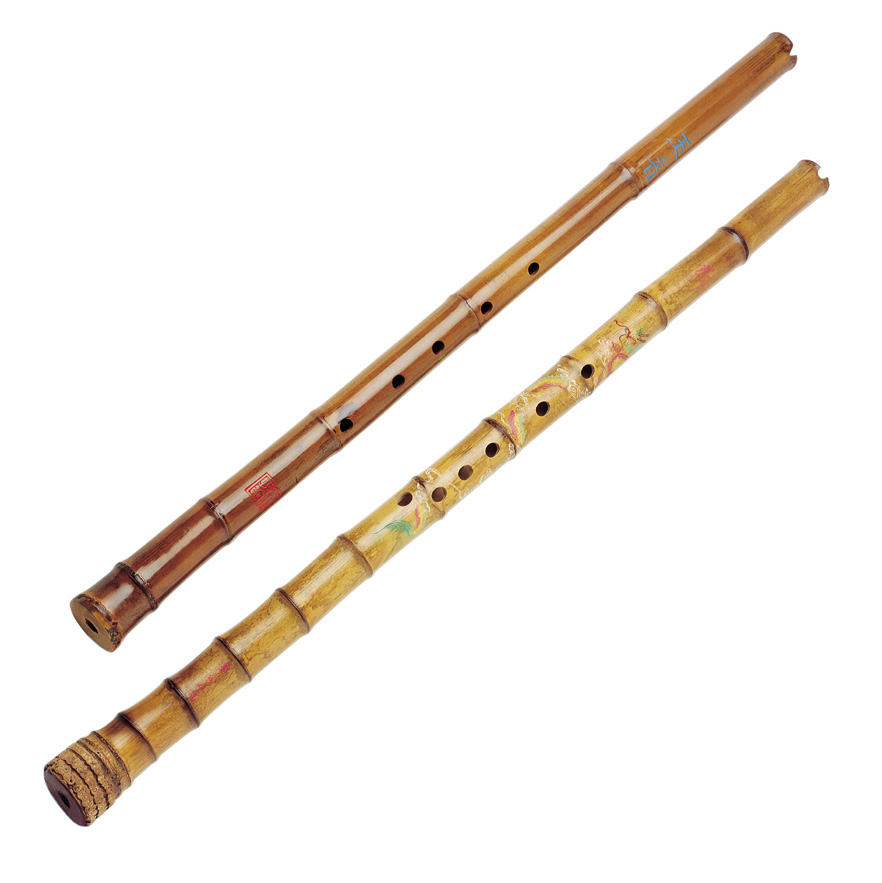
现在的箫在汉魏六朝时代称为篴(di即笛)。篴从我国西北羌族地区传到中原地区,最初只有四个按孔,西汉京房(公元前七七年至前三七年)在背面加一孔,才有了五个按孔。晋代乐工列和在西元二四七年左右所吹的笛(箫),已有六个按孔,与今天的箫差不多。
唐代有一种称为尺八的吹管乐器,形制与今天的箫相似,但另加有贴竹膜的孔。唐宋以来,渐将篴改称为箫或洞箫。
箫在魏晋南北朝时,已用于伴奏、合奏和独奏。晋桓伊曾在笛(箫)上作三弄调;在魏晋南北朝伴奏相和歌的乐队中,都用到笛(箫)。现在的箫仍用于伴奏、合奏和独奏。
箫,竹制,直吹,按孔为前五后一,上端开一吹口孔。音色圆润、柔和。
Xiao was the wind instrument of China. It was first appeared in Han dynasty and was called di. Di was spread by the Jiang tribe from the north-west to the central area of China. It originally had only four holes. Jing Fang of Han dynasty added one hole at the back of it and became a five holes instrument. Lie He of Jin dynasty made it to a six-hole one and almost the same as today’s instrument. In Tang dynasty, there was a wind instrument called Shakuhachi which was similar to the xiao of today. It has a hole for the bamboo membrane sticker. Since Tang dynasty, di was steadily changed the name to xiao or dongxiao. The instrument is made of bamboo with five holes in the front and one hole in the back. It was blowing vertically at the upper end to produce a soft musical sound.
骨哨与骨笛
Gushao (Bone Whistle)
Gudi (Bone Flute)
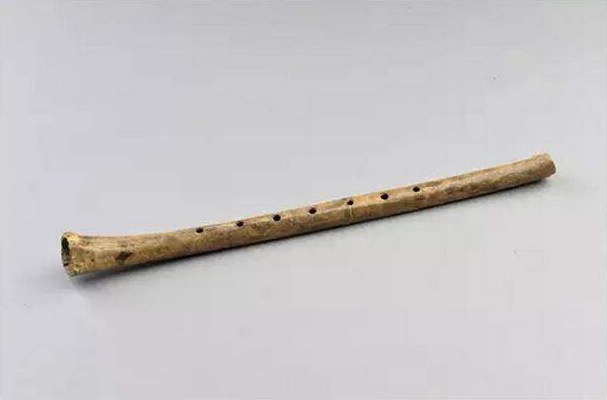
一九七三年浙江馀姚市河姆渡遗址出土了一百六十件骨哨和骨笛,据测定是属新石器时代遗物,距今已有约七千年左右的历史。河姆渡的骨哨用禽鸟的肢骨中段制成,长约六至十釐米不等,中空,器身略有弧度在凸弧一侧磨有一至三个圆形或椭圆形孔,有的在一侧两端各穿一个孔,也有一边堵塞,一边是窑,二头空叫哨,一头堵住的叫笛,骨哨与骨笛的区别在此。河姆渡骨哨和骨笛仍可吹出简单的音调,声音尖税,与鸟鸣声相像。可能是先民们利用骨哨发出的鸟鸣声诱捕各种飞禽,或发出简单的声音讯号,其中一支结构像儿童们玩的竖笛。骨哨与骨笛不仅是笛子的鼻祖,而且是迄今为止在我国发现的年代最久的乐器。
–Gushao (Bone Whistle) and Gudi (Bone Flute)
In 1973, a hundred and sixty pieces of bone shao (whistles) and dizi were unearthed at Hemudu Site in the city of Yuyao of Zhejiang province. The bone relics, according to the science reports, were the remains of the New Stone Age, roughly 7000 years ago. Bone whistles at Hemudu Site are made of the mid-sections of bird limbs, of varying lengths ranging from six to ten centimeters. Shao are made of bones hollowed out, with one to three circular or oval holes on the convex surface of it. Some have two holes made at one end, while others have holes on both, which is how a shao differs from a di. Gushao has holes at one end while gudi has holes at both ends. The bone whistles and flutes excavated at Hemudu are capable of producing simple, high-pitched sounds like the birds. The primitives may have used them to catch game, or sent out messages. One of these pieces resembles the kind of flute children play today. Gushao and gudi are not only the prototypes of flutes, but also the earliest musical instruments hitherto unearthed in the country.
排箫 - Paixiaio

排箫,古代吹奏乐器。原称箫。《世本》:“箫,舜所造。其形参差象凤翼,十管,长二尺。”;《博雅》:“箫,大者二十四管,无底;小者十六管,有底。”;《三礼图》:“无底者谓之洞箫”。汉、唐以来石刻、壁画及随葬陶俑中常可见到吹奏排箫的形象。宋以后民间失传,只用于宫廷雅乐。湖北随县曾侯乙墓出土有排箫,竹制、编管十三,按长短依次排列,最长者二十二点五釐米,最短者五点一釐米,用三道篾篐束结,是目前考古发现年代最早的实物。近人从甲骨文仑字的形态,认为仑或籥,是一种编管乐器,接近排箫的原始形制。
–Paixiao
Paixiaio was a kind of ancient wind instrument of China. It was originally called xiao. The old history book mentioned that it was made by emperor Shun according to the shade of the phoenix’s wing. The instrument had ten tubes in two rulers’ length. Another ancient record mentioned that the bigger xiao had twenty-four tubes in free end and the smaller one had sixteen tubes with a closed end. Other book defined that the free-ended one was call dongxiao. We can always find the performing figures of paixiao from the rock carvings, paintings and pottery of Han and Tang dynasty. After the Song dynasty, paixiao had disappeared in the nongovernmental activity, it was only used at the court. In Sui county of Hebei province, there unearthed a bamboo paixiao with thirteen tubes setting order according to the tubes’ length. The longest one was 22.5 cm and the shortest one was 5.1 cm bound together by three bamboo strips. This was the oldest archaeological discoveries of paixiao.
葫芦丝 - Hulusi

葫芦丝,是流行于傣、彝、阿昌等民族的乐器。这种乐器用半截小葫芦作为音箱,以三根长短不一的竹管并排插在葫芦内,插入葫芦的竹管下端,嵌有铜质簧片,中间较长的一根竹管开七孔(前六后一)。
吹奏时,口吹葫芦细端,指按中间竹管的音孔,在奏出旋律的同时,左右两根竹管同时发出固定的单音,与旋律构成和音。葫芦丝音色柔和,常用于独奏和合奏。
Hulusi was a popular musical wind instrument of Dai, Yi and A-Chang tribes. The sound box is made of a dried fruit called hulu. There are three bamboo tubes with brass reeds in different length inserted. The longest one has opened six holes in the front and one hole in the back of it. By blowing the small end of the hulu and pressing the holes of the bamboo tube, we may produce beautiful musical sounds. The other bamboo tubes can also produce two sounds for harmony. It is commonly used as solo instrument and in ensemble works.
唢呐 - Suona
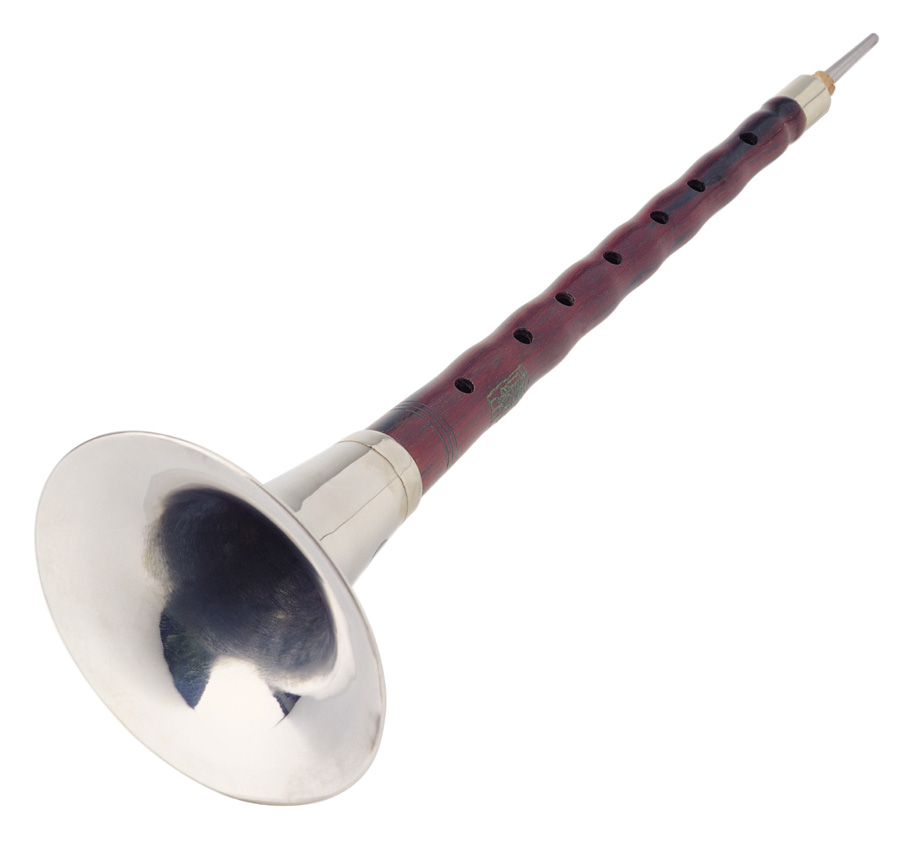
唢呐又名喇叭,小唢呐又称为海笛。两晋时期(公元二六五至四二○年)已流行于新疆地区。清代唢呐在回部乐中使用,称为苏尔奈。它是民间运用最广泛的乐器之一,除了用于合奏、独奏外,也用于戏曲、歌舞等伴奏。在民间,每逢喜庆节日,吹打和锣鼓乐队中大都离不开唢呐。
唢呐,在木制的锥形管子上开八孔(前七后一),木管上端装一铜管,铜管上端套一苇制哨子,木管下端接一喇叭形铜质扩音器。音色高亢明亮,有的民间艺人能控制气息,吹出柔美的箫音。
经过改革的唢呐有高、中、低三种,有的还加了音键,扩大了音域。
Suona is also called the trumpet. The smaller suona is called haidi. Since Jin dynasty, it was widely spread in Xinjiang. In Qing dynasty, it was called suernai. It was the most widely used musical instrument. Apart from the ensemble and solo, it was also be used in accompaniment of opera and dance. During the festival days, it was used together with other wind instruments and the percussions. The instrument has a conical tube with seven holes in the front and one in the back. At the small upper part, there is a brass system with a reed whistle. While at the bigger lower part is installed with a brass loudspeaker. Its sound is bright and some artists can control it to produce soft sound like the xiao. The suona has been reformed to consist of high, medium and low pitch series with difference keys.
管 - Guanzi
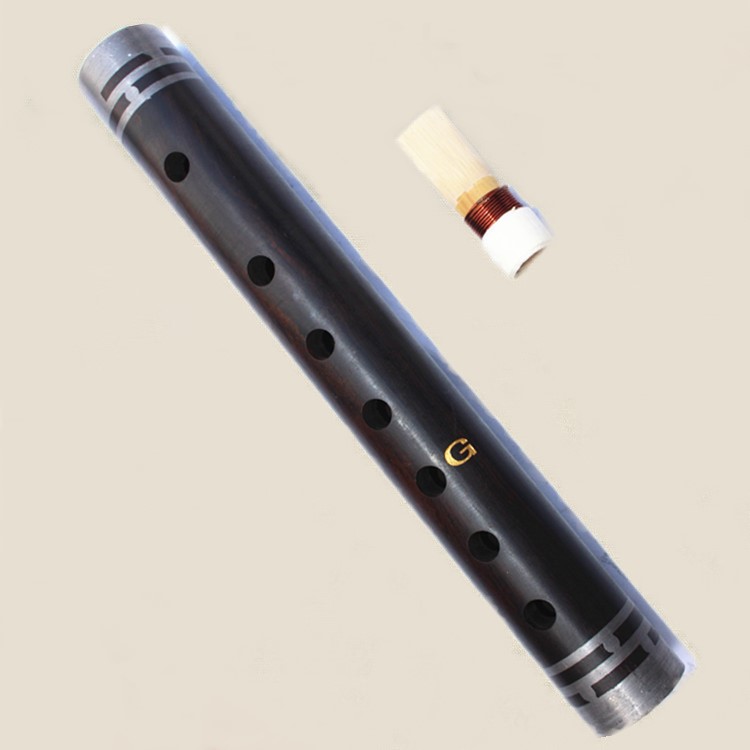
管,流行于我国北方。古称筚篥(bi li)或觱篥。北魏云岗石窟(公元四六○至四九四年)雕刻中已有管。隋唐九、十部乐中,有好几部用到筚篥。北宋教坊十三部中有筚篥部。
管,木制,上开八孔(前七后一)。管口插一苇制的哨子。管的音色高亢。在北方管乐队中常常用以领奏。
新中国成立后,管的制造和吹奏技术都有了发展。经过改革的管,音域扩展为二组又六个音,加键管能演奏十二个半音,在合奏和独奏中发挥更大的效能。目前在乐队中经常使用的有中音管、低音管和加键管。
Guanzi is spread popularly in the northern part of China. In ancient time, it was called bi li. In the Yungang Stone Grottoes of Northern Wei dynasty, there were carved with guanzi. Many ensembles of Sui and Tang dynasty used guanzi as their main instruments. In Song dynasty, the music training department also included bi li in their project. The instrument was made by using a wooden tube as sound box, which had seven holes in the front and one in the back. It was performed vertically by blowing the reed whistle at the upper end. The sound of it is bright and always be used as leading instrument in the northern ensembles. Nowadays, guanzi has developed to have wider range and can play semitones.
双管 - Shuangguan
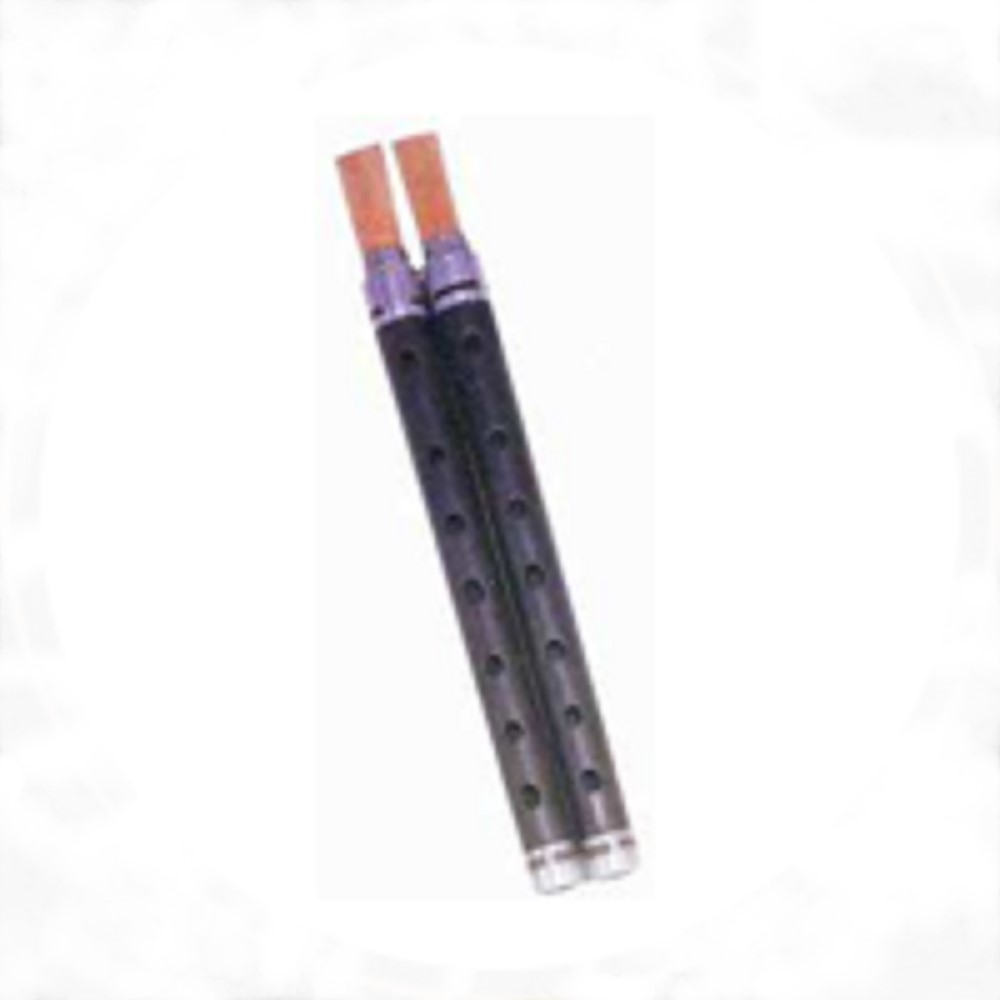
双管,系将两支管并排扎结一起吹奏,流行于东北、华北广大地区,多用于独奏、合奏。
东汉郑玄注《周礼‧春官‧小师》:“管如篴而小,并两而吹之”。可见当时已存在双管类乐器。《隋书‧音乐志》载龟兹乐中有双筚篥。新疆吐鲁番东北部的伯孜克里克石窟(开凿于五五○至一三六八年)第二十九窟有双筚篥图像,双管并列,管身有五个按孔。宋陈暘《乐书》中载有双筚篥:“胡部安国乐器有双筚篥,《唐乐图》所传也”。
又有双凤管:“双凤管合两管以足十二律之音,管端施回簧,刻凤以为首,左右各四窍”。表明双管自唐以来已广为应用。
现代双管由两支长短、音高相同的管子并排扎结而成。每管八孔(前七后一)。九孔管已很少见到。演奏时,可以两管并吹,也可将两管分开,两手各持一管,手指各按管子上方的三个音孔,交替吹奏短促的音符,以烘托气氛,把乐曲推向高潮,代表性乐曲有《江河水》等。
Shuangguan is binded with two guanzi side-by-side. It is always be used in the northern part of China for solo and the ensemble. ZHENG Xuan of Han dynasty mentioned on his book an instrument some what like Shuangguan. In the music volume of Sui dynasty, there were double bi li. There was a double five-hole bi li carved in the Stone Grotto of Bazi Kerik in Xinjiang. CHEN Yang of Song dynasty, had described in his Book of Music about the double bi li. In Tang dynasty, there was a widely used instrument called double phoenixes guan. It was so called because there were carved with a phoenix on each end of the two pipes. These two pipes together can play twelve semitones. Nowadays, the shuangguan is an instrument by binding with two guanzi of the same length and pitch together. Each guanzi has seven holes in the front and one in the back. During performance, the performer can play two guanzi together or separately by using three fingers pressing the upper three holes to perform short notes. The representative music of shuangguan is River Water.
喉管 - Houguan
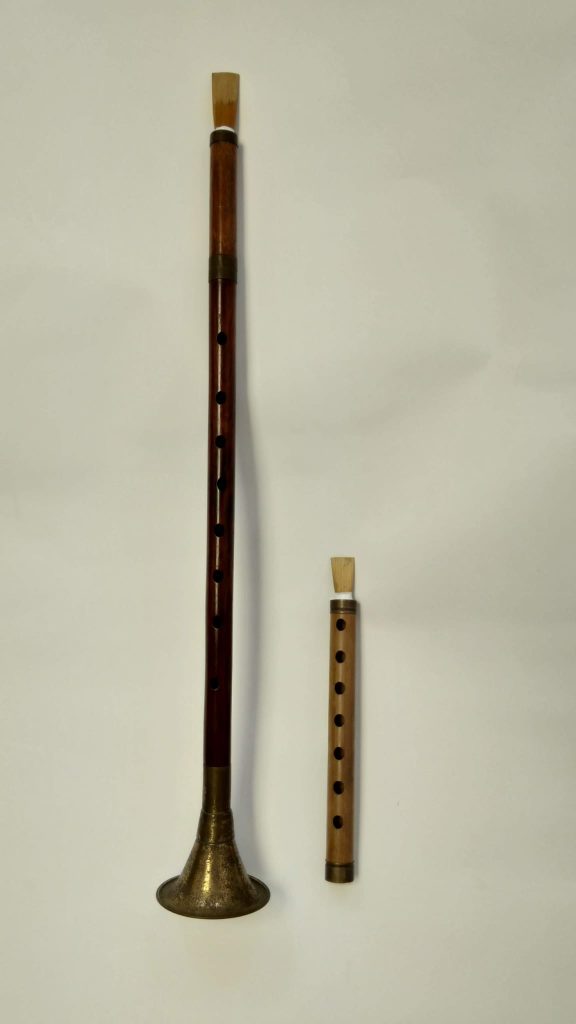
喉管,又称竹管,短小的称为“短管”,长而低音的并于管身下端加碗者称为“沉筒”。本世纪二十年代末用于演奏广东音乐和粤剧伴奏,后流行两广地区。五十年代初,又发展出中音和低音喉管。
喉管由哨、管身和喇叭口构成。哨芦苇制,两片相对合成,哨口较宽而哨片较厚。管身用长茎竹、红木、塑胶管或金属管制成,上开七孔,音色各异,以竹制为佳。管下端装铜制喇叭口。低音喉管还设铜制曲颈。中音喉管全长约五十三、内径一至一点三釐米;低音喉管全长约八十五、内径一点四至一点七釐米。
民族乐队常用G调中音喉管和D调低音喉管。不能超吹。音域分别为d-d1和A-a。通过控制哨子,可转近关係调。喉管发音接近管的低音区,在乐队中常与中胡或低胡结合使用,以加强中、低音声部。多用单吐法,可奏滑音、叠音、花舌和颤音等。
二十世纪六十年代出现加键喉管。管身加装按键,开十八或十九个按音孔,设一个泛音孔,可以超吹(如筒音g,超吹发高十二度的d2)、演奏半音阶,适于转调。音域两个半八度,可用于独奏。
Houguan is also called bamboo pipe. The shorter one in high pitch is known as duanguan. While the longer one with a brass loudspeaker at the lower end and in low pitch is known as chentong. In the late of 1920s, it was used for performing Guangdong music and accompaniment of Guangdong opera. It was later widely spread in Guangdong and Guangxi. In the early 1950s, it was developed to have alto and bass houguan. The instrument is consisted of the whistle, the pipe and the loudspeaker. The whistle is made of reeds. The pipe is either made of bamboo, hard wood, plastic or metal. It is opened with seven holes and can produce different sound quality according to the substance of the pipe. It is the best of the bamboo ones. For chentong, it has a brass made loudspeaker at the lower end to enlarge the sound produced. In the traditional orchestra, it is always used the G alto houguan and the D bass houguan. The range is set at d-d1 and A-a. By controlling the whistle, it can change the melody to relative tones. Houguan produce sound of bass like the guanzi and always be used together with zhonghu in the ensemble. After 1960s, It is developed to install mechanical system to wider the performance techniques and range. It can play semitones of two and a halve octaves. It is now developed to a solo instrument.
口笛 - Koudi
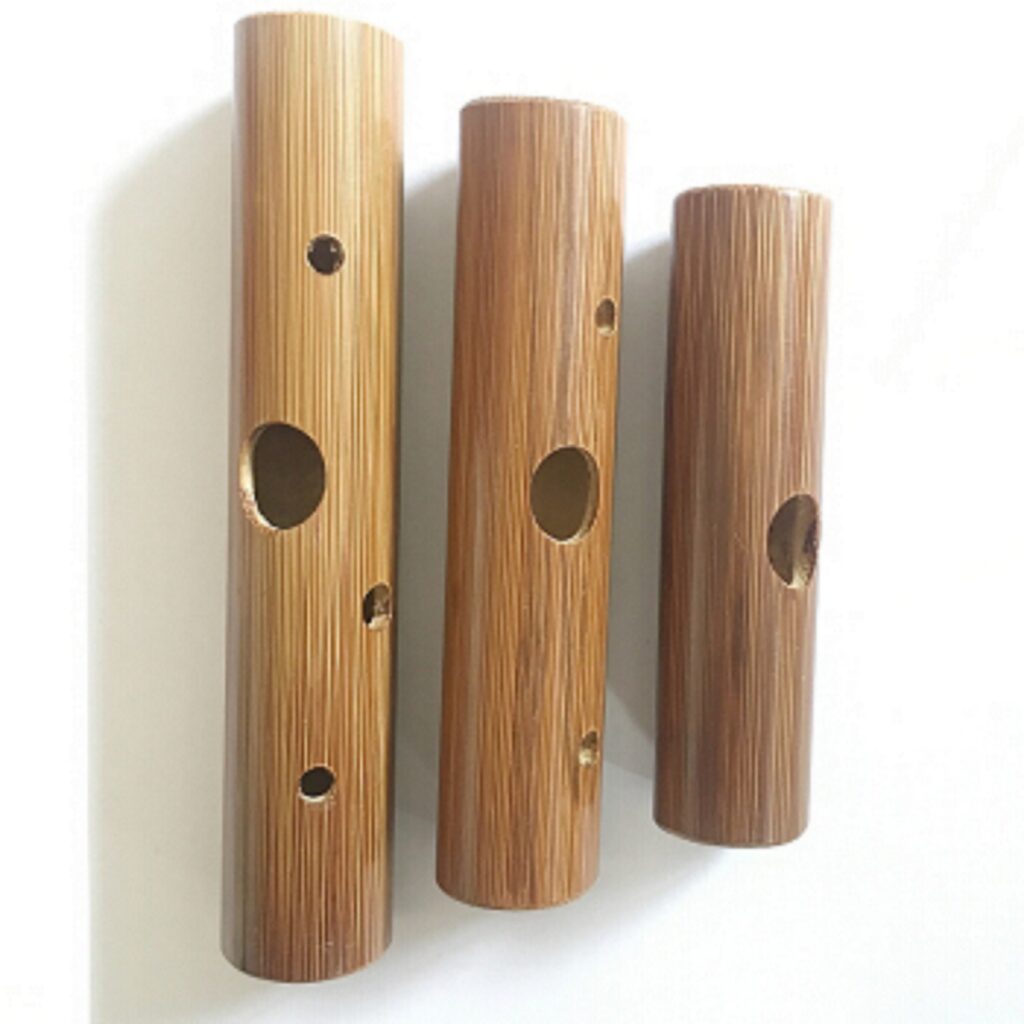
口笛,上海民族乐团俞逊发创制的新型吹奏乐器。
用黄枯竹或小水竹制作,也可用长茎竹、凤眼竹或紫竹。在一段短而细的竹管上,中间开一吹孔,利用管端的自然孔,成为两孔口笛,若在近吹孔处再开三个音孔,称为五孔口笛。
演奏口笛,左、右手拇指控制第二、一孔,左手食指按第三孔,右手中、食指按第四、五孔。音孔全按发出最低音,开一孔发上方纯四度音,开一、二孔为纯八度音,两拇指在音孔上移动,多开或少开一点音孔,一、二孔可分别发出四度以内音阶。
口笛發音近似哨音,音量較大,穿透力強。可演奏歡快、優美的旋律,模仿百鳥爭鳴和接近人聲的唱腔。獨奏曲有《苗嶺的早晨》、《雲雀》和改編的《陽光照耀著塔什庫爾幹》等。
Koudi is a newly invented wind instrument by YU Xun-fa of the Shanghai Chinese Orchestra. It is made from a small portion of bamboo tube with a blowing hole opened in the middle. By using the natural ends of the tube to perform is the two-hole koudi. If we open three more holes near the blowing hole, it is the five-hole koudi. When performing, the second and the first hole are controlled by the left and right thumbs. The third hole is controlled by the left index finger. While the fourth and the fifth holes are controlled by the right middle and index fingers. The lowest note can be produced by closing all five holes. The sound it produced is some what like the whistle. It has high frequency and volume. Its tone colour possesses a strong penetrative quality. It can play beautiful melodies and imitation of bird-calls. The solo pieces for koudi include Morning at Mount Miao, The Lark and the adaptation of Sunshine on Taxkorgan.
巴乌 - Ba-u

巴乌,云南省彝、苗、哈尼等少数民族使用的单簧吹管乐器。
巴乌用竹管制成,有八个按孔(前七后一),吹口处装一尖舌形铜质簧片。演奏时横吹上端,振动簧片发声。巴乌音量较小,音域较窄,但音色柔美。常用于伴奏舞蹈、说唱,也能独奏。近年来,对巴乌进行了改革。改革后的巴乌管身略粗,加四个键子,音域有所扩大,音量增加。
Ba-u is a single reed wind instrument of minorities Yi, Miao and Hani in Yunnan. The instrument is made of bamboo tube with seven holes opened in the front and one in the back. There is another blowing hole installed with a brass reed. It is performed horizontally by blowing the brass reed and pressing the other holes to produce musical sounds. The sound it produce is small, soft and beautiful, but the range is narrow. It is always used for the accompaniment of dance and sing, sometimes used for solo. In recent years, it has been reformed to have wider range and volume.
埙 - Xun
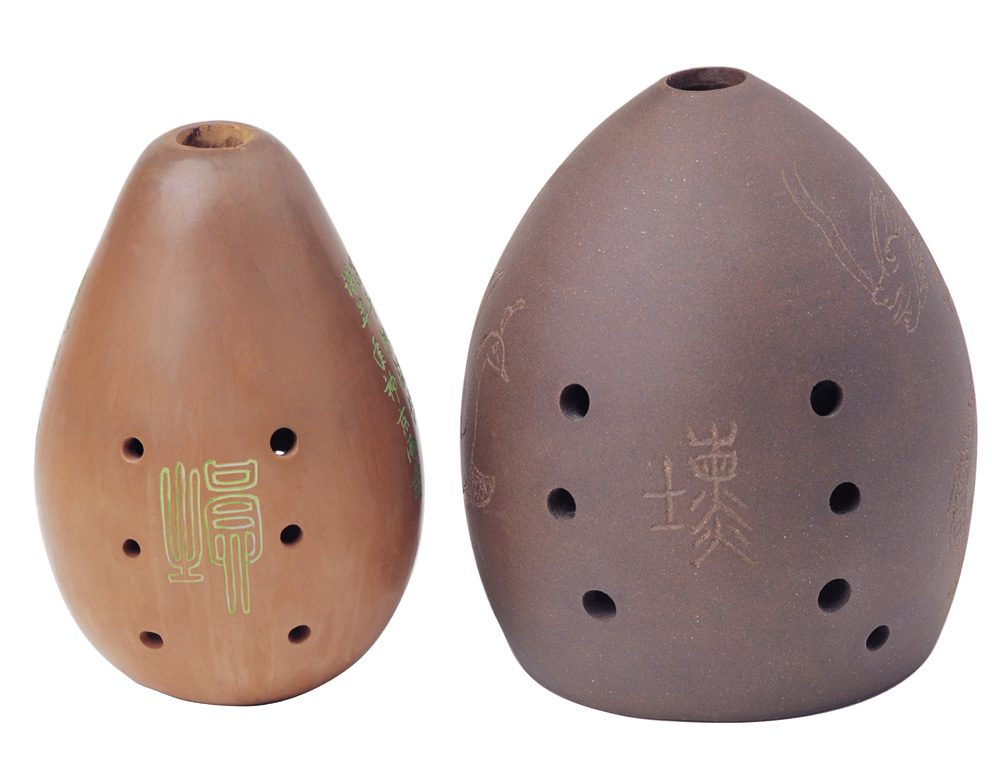
埙是一种用陶土烧制的乐器,同其他乐器一样,它是伴随著劳动而产生发展的,埙的历史可以追溯到新石器时期。
我国发现最古老的埙,一个是七千年前我国浙江杭州湾河姆渡原始居民使用的一孔埙,另外两个是在我国西安半坡村母系社会遗址出土的。
埙这种乐器还在我国山西、甘肃、河南、山东省等地出土过。从出土文物看,埙经历了漫长的发展阶段。古代埙的样子很多,有梨形、鱼形、球形和笔管形等,制作埙的材料有陶、石、玉、木、象牙等,后来多是陶制的。
今天,埙重获新生,应当归功于那些热心于挖掘、研制、改革、创新的民族音乐家和演奏家,在他们的艰苦努力下,埙的音域不断扩展,已由过去的六个音孔增加到十几个音孔,能够顺利地奏出十二平均律,埙的表现力得到了极大地丰富,埙的演奏技巧的不断创新,作品的不断涌现,使埙这一古老的乐器又重新焕发了青春。如今的埙不仅能吹出古雅深沉、如泣如诉的悲凉旋律,而且能奏出热情奔放、诙谐幽默的欢乐乐章。
Xun is a wind instrument made of pottery. Its development was engaged to the manual labour in the early times. Its history can be traced back to the Neolithic period. One of the oldest xun of 7000 years before was unearthed in Hemudu of Zhejiang province. This was a single hole xun. Another two were unearthed in Banpo village of Xi’an. Xun were also unearthed in Shanxi, Gansu, Henan and Shandong provinces. It had undergone a long period of development and had different shapes like pear, fish, spherical and tubular. The manufacturing material included pottery, stone, jade, wood and ivory. But the most common one is earthenware. Today, we can easily approach the xun must attribute to those musicians and instrumentalists who are hard working in unearth, research, reform and bring forth new ideas. They have developed it to an over ten holes instrument and can play semitones. Today, xun is not only to play ancient melodies, it can also play melodies of warm, flowing, joy and with humor.

